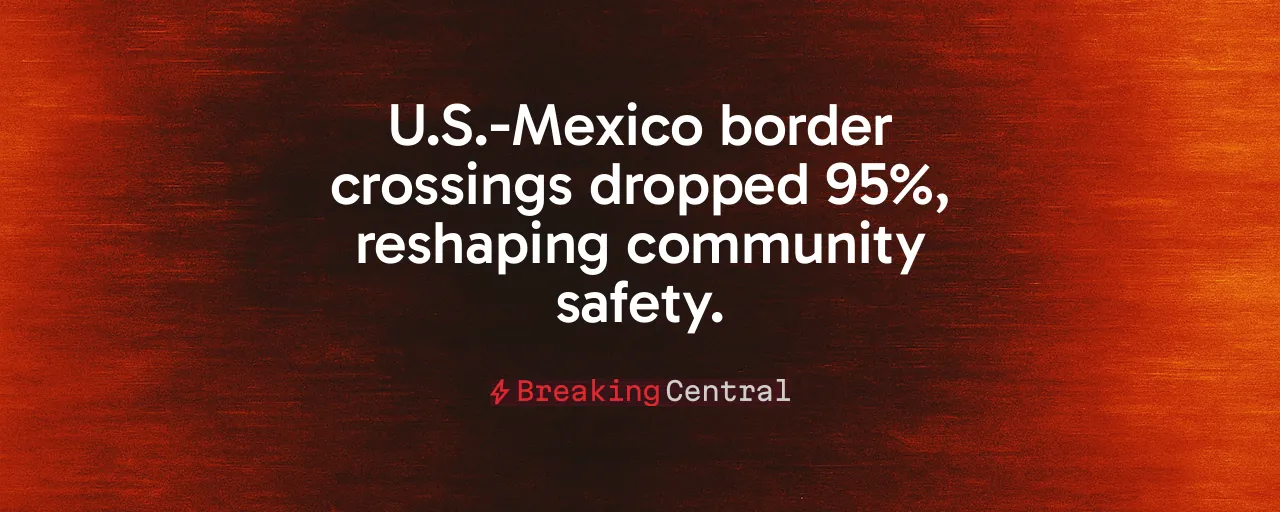A Border Reborn
The U.S.-Mexico border has undergone a seismic shift. A year ago, over 100,000 migrants crossed monthly, overwhelming agents, flooding shelters, and straining communities. Now, the numbers stun in a new way: fewer than 10,000 crossings a month, a 95% drop. Journalists visiting 15 border sites from California to Texas found quiet shelters and relieved locals. This change reflects a promise delivered with breathtaking speed.
President Trump's second term has achieved what skeptics deemed impossible. His pledge to halt illegal crossings has taken root, transforming a porous frontier into a symbol of resolve. Why does this resonate? A secure border protects communities, safeguards jobs, and ensures America controls its future. It's a victory for every citizen who values order.
Advocates for open border policies label this a humanitarian disaster. Their argument lacks weight. The true disaster was the unchecked influx that drained resources and invited chaos. Trump's policies have restored clarity, backed by hard data. Yet he insists the work continues. Is his urgency justified?
The evidence suggests yes. A $150 billion spending bill passed by the House drives this progress, funding walls, detention centers, and deportations. These investments prioritize sovereignty over sentiment. Americans demanded a functional border, and they're seeing results.
Challenges persist. Cartels adapt, smugglers pivot, and advocates for weaker enforcement press on. Trump's call for vigilance rings true. A nation without secure borders loses its foundation.
Bold Moves, Real Results
How did this turnaround happen so swiftly? Trump's first 100 days laid the groundwork. A national emergency declaration, 10,000 deployed troops, and rapid wall construction sent an unmistakable signal: America means business. Border apprehensions fell to 7,181 in March 2025, a historic low. This reflects a calculated strategy, demonstrating a deliberate outcome.
Executive orders labeled illegal migration an urgent threat, mobilizing military support and state-federal partnerships. A 2024 rule barring most asylum seekers who cross between ports cut encounters further. Reopened family detention centers and expanded capacity toward 100,000 beds reinforced the message. Fast-tracked deportations, despite legal challenges, underscore a commitment to action.
Compare this to the prior administration's record. Under Biden, crossings increased, enforcement efforts faced criticism, and some localities saw challenges in managing migrant flows. Communities paid the price. Trump's approach rejects that legacy, choosing deterrence over hesitation.
Groups like Amnesty International decry the loss of asylum rights. Their critique misses the mark. Asylum exists for the genuinely persecuted, distinct from its use as a gateway for millions seeking better prospects. Data confirms most crossings stem from economic motives, rather than fear. Why should American taxpayers subsidize that?
Prioritizing America's Interests
The financial commitment is substantial but essential. Congress allocated nearly $34 billion for CBP and ICE in FY 2025—more than all other federal law-enforcement combined—before consideration of the new House reconciliation bill. The reconciliation package moving through Congress would inject an additional $168 billion into immigration enforcement, pushing available funds toward $200 billion and dwarfing spending on tax, firearms, drug and general FBI investigations. Separate House GOP budget legislation would earmark over $150 billion across five years, including $51 billion for new wall segments and facilities and $59 billion for detention and transportation of immigrants. These funds reflect clear priorities: safety, order, and American workers.
Contrast this with proposals from open-border advocates. They push for billions in processing, legal aid, and resettlement, programs that incentivize more crossings. Such plans burden citizens and reward lawbreaking. The House GOP's budget, with its $4.7 billion contingency fund and fentanyl detection tools, emphasizes prevention. Don't taxpayers deserve that focus?
Local outcomes reinforce the strategy. Border towns, once overwhelmed, now breathe easier. Emergency services face less strain, allowing communities to address their own needs. Some businesses note labor shortages, but history shows reduced migration sparks innovation, as seen in the 1920s with agricultural mechanization. America will adjust.
Answering the Detractors
Opponents, including analysts at Brookings and advocates at WOLA, highlight economic and humanitarian risks. They warn of GDP losses from reduced migration and dangers faced by migrants stranded in Mexico. Their concerns, while earnest, misplace priorities. A nation's primary duty is to its citizens, prioritizing their welfare over those who violate its laws. Labor gaps can be filled through legal channels, avoiding unchecked inflows.
The humanitarian critique stings but lacks perspective. Yes, Mexico's border towns pose risks, and asylum seekers endure hardship. Yet decades of lax enforcement encouraged these surges. Trump's policies reset the equation: the U.S. border is a controlled entry point. Harsh? Perhaps. Essential? Undeniably.
The UN and Amnesty argue this breaches international law. They overreach. Nations hold the right to secure their borders. Non-refoulement balances compassion with practicality, without constituting an obligation to admit all. Trump's approach upholds this, preserving legal pathways for those who qualify while safeguarding American interests.
A Stronger America Emerges
The border's revival marks a triumph for Americans who cherish security and sovereignty. Trump's policies have turned disorder into discipline, proving bold leadership delivers. The $200 billion funding goal builds a future where America dictates its immigration terms, prioritizing citizens first.
The fight isn't finished. Cartels persist, and global migration pressures endure. Yet today, the border is calmer, communities are safer, and the nation stands prouder. Americans sought a leader who would act, and they found one. What lies ahead? Sustaining this progress with unwavering resolve.
To doubters, consider the empty shelters and relieved border towns. The results speak loudly: Trump's vision is succeeding. It's time to unite behind a safer, stronger America, one border at a time.
